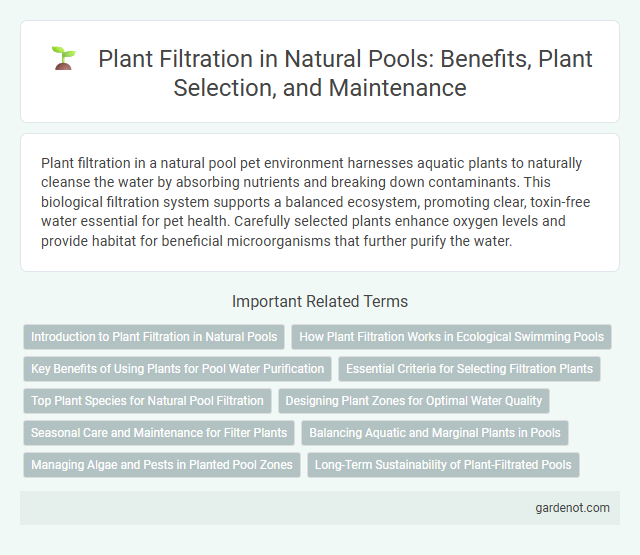Plant filtration in a natural pool pet environment harnesses aquatic plants to naturally cleanse the water by absorbing nutrients and breaking down contaminants. This biological filtration system supports a balanced ecosystem, promoting clear, toxin-free water essential for pet health. Carefully selected plants enhance oxygen levels and provide habitat for beneficial microorganisms that further purify the water.
Introduction to Plant Filtration in Natural Pools
Plant filtration in natural pools harnesses aquatic vegetation to maintain water clarity and balance by absorbing nutrients and filtering contaminants. Submerged, emergent, and marginal plants work synergistically to reduce algae growth and promote a healthy ecosystem. This biological filtration method supports sustainable water treatment and enhances biodiversity within the pool environment.
How Plant Filtration Works in Ecological Swimming Pools
Plant filtration in ecological swimming pools operates by using specific aquatic plants to absorb nutrients and filter out impurities from the water, mimicking the natural purification processes found in wetlands. These plants facilitate the growth of beneficial microbes on their roots, which break down organic matter and harmful bacteria, enhancing water quality without chemicals. This biological filtration system maintains clear, clean water while promoting a balanced aquatic ecosystem.
Key Benefits of Using Plants for Pool Water Purification
Plants in natural pools serve as efficient biofilters, removing impurities and excess nutrients from the water through their root systems. This biological filtration reduces the need for chemical treatments, promoting a healthier and more balanced aquatic environment. Moreover, aquatic plants enhance oxygen levels and support beneficial microbial activity essential for maintaining clear, clean pool water.
Essential Criteria for Selecting Filtration Plants
Selecting filtration plants for a natural pool requires prioritizing species with high nutrient uptake, rapid growth rates, and resilience to seasonal variations. Plants such as water lilies (Nymphaea spp.), cattails (Typha spp.), and bulrushes (Schoenoplectus spp.) excel at absorbing excess nutrients and maintaining water clarity. Ensuring a diverse mix of submerged, floating, and marginal plants enhances biofiltration efficiency and supports a balanced aquatic ecosystem.
Top Plant Species for Natural Pool Filtration
Top plant species for natural pool filtration include water lilies (Nymphaea spp.), cattails (Typha spp.), and reeds (Phragmites australis), which are highly effective in maintaining water clarity and quality. These plants facilitate nutrient uptake, reduce algae growth, and provide oxygenation essential for beneficial microbial activity. Incorporating a diverse range of aquatic plants enhances the ecosystem's balance, promoting natural purification and sustainable pool maintenance.
Designing Plant Zones for Optimal Water Quality
Designing plant zones in natural pools involves strategically placing various aquatic plants to enhance water filtration and maintain optimal water quality. Emergent plants like cattails and reeds are positioned near the water's edge to absorb excess nutrients, while submerged plants such as hornwort and elodea oxygenate the water and support beneficial microbial activity. Floating plants like water lilies provide shade and reduce algae growth, creating a balanced ecosystem that naturally filters contaminants and promotes clear, healthy water.
Seasonal Care and Maintenance for Filter Plants
Seasonal care for natural pool filter plants involves regular pruning to remove dead or decaying foliage, which prevents nutrient buildup and maintains water clarity. Nutrient absorption peaks during spring and summer, requiring tailored fertilization while avoiding overfeeding to prevent algae growth. In winter, reducing plant density protects roots from freezing and allows healthy regrowth in spring, ensuring sustained filtration efficiency.
Balancing Aquatic and Marginal Plants in Pools
Balancing aquatic and marginal plants in natural pools enhances plant filtration by optimizing nutrient absorption and supporting diverse microbial communities. Aquatic plants such as water lilies and hornwort absorb nutrients directly from the water, reducing algae growth, while marginal plants like cattails and reeds filter runoff and stabilize pool edges. Proper selection and distribution of these plants maintain water clarity and ecological balance, ensuring sustainable pool health.
Managing Algae and Pests in Planted Pool Zones
Plant filtration in natural pools effectively manages algae and pests by utilizing diverse aquatic plants that absorb excess nutrients, reducing conditions favorable for algae growth. Root systems of submerged and marginal plants enhance water clarity by filtering suspended particles and supporting beneficial microbial populations that control pest outbreaks. Regular maintenance of planted pool zones ensures balanced nutrient levels, promoting a healthy ecosystem resistant to invasive algae and pest infestations.
Long-Term Sustainability of Plant-Filtrated Pools
Plant filtration in natural pools enhances long-term sustainability by utilizing aquatic plants that naturally absorb nutrients, reduce algae growth, and maintain water clarity. These plants create a balanced ecosystem that minimizes the need for chemical treatments and energy-intensive filtration systems. Over time, the established plant roots stabilize sediment and support beneficial microbial communities, ensuring effective, eco-friendly water purification.
Plant filtration Infographic

 gardenot.com
gardenot.com